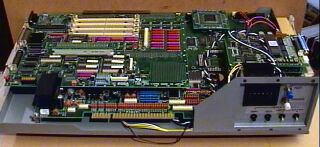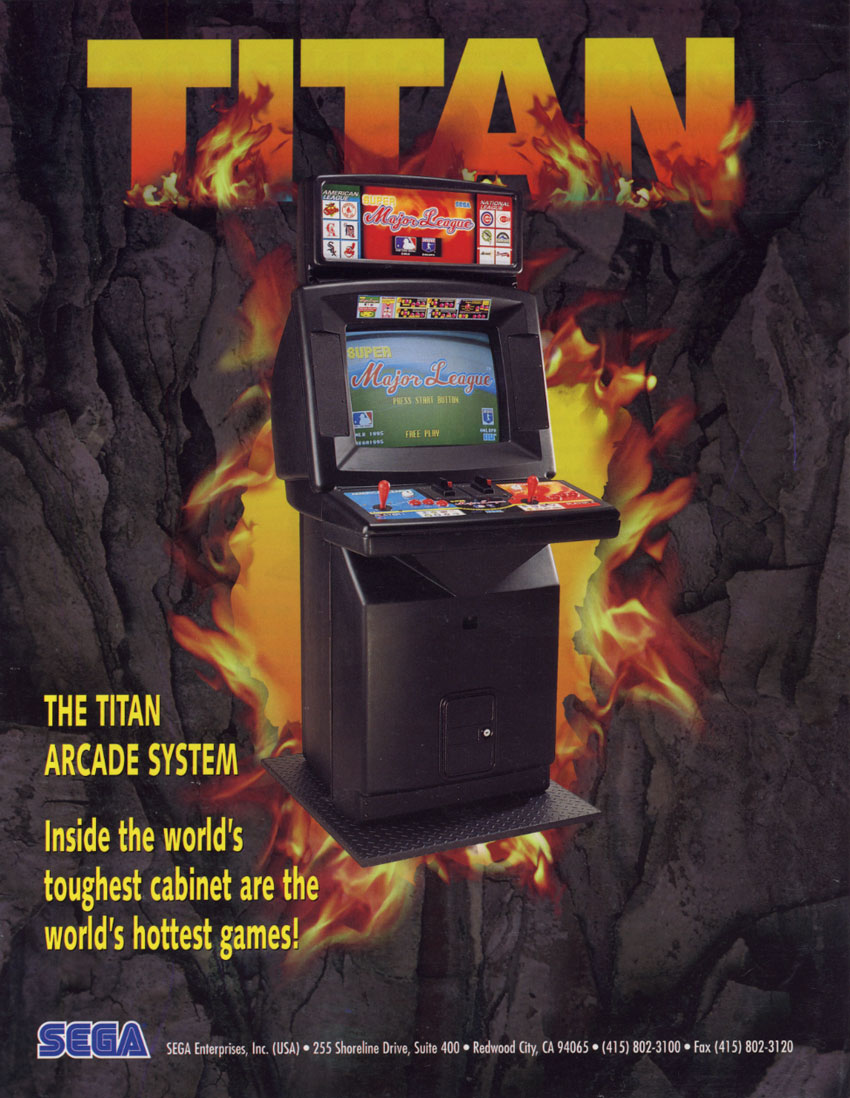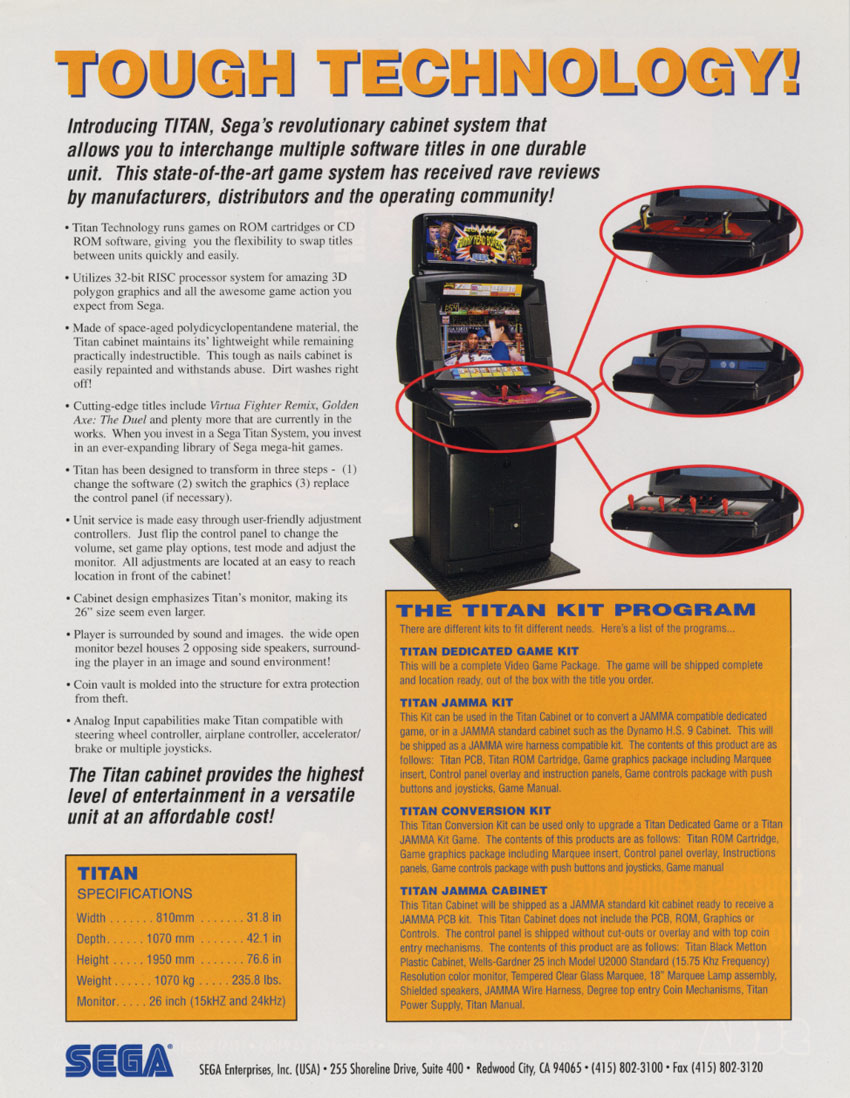Sega Titan Video
From Sega Retro

| |||||||||||||

| |||||||||||||
| Sega Titan Video | |||||||||||||
|---|---|---|---|---|---|---|---|---|---|---|---|---|---|
| Manufacturer: Sega Enterprises, Ltd. | |||||||||||||
| Variants: Sega Saturn | |||||||||||||
|
ST-V (Sega Titan Video) is an arcade system board released by Sega, in 1994 for Japan and 1995 worldwide. Departing from their usual process of building custom arcade hardware, Sega's ST-V is essentially identical to the Sega Saturn home console system. The only difference is the media; ST-V used ROM cartridges instead of CD-ROM discs to store games, with the exception of Sports Fishing 2. Being derived from the Saturn hardware, the ST-V was presumably named after the moon Titan, a satellite of Saturn.
The majority of ST-V titles were released only in Japan, but a notable exception was the port of Dynamite Deka, which became Die Hard Arcade. Games released for the ST-V include the arcade versions of Virtua Fighter Remix, Radiant Silvergun, Golden Axe: The Duel, and Final Fight Revenge. The shared hardware between Saturn and ST-V allowed for very "pure" ports for the Saturn console.
Contents
Technical specifications
- See Sega Saturn Technical Specifications for full specifications
- Main CPU: 2x Hitachi SH-2 @ 28.6 MHz in a master/slave configuration
- Custom Saturn Control Unit (SCU): Fixed-point math coprocessor
- VDP1 32-bit video display processor - handles sprite and polygon drawing. Dual 256 KB framebuffers for rotate and scale effects. Texture mapping, Gouraud shading. 512KB texture RAM
- VDP2 32-bit background and scroll plane video display processor - transparency effects, shadowing, 5 simultaneous scrolling backgrounds and 2 simultaneous rotating playfields
- Sound CPU: Motorola 68000 @ 11.45 MHz
- Sound chip: Yamaha YMF292-F SCSP @ 11.3 MHz
- Main RAM: 2MB
- VRAM: 1.54MB
- Audio RAM: 512K
List of games
- Virtual Batting (1994)
- Waku Waku Tama & Friends (1994)
- Sports Fishing (1994)
- Pro Mahjong Kiwame S (1995)
- Shanghai: Triple-Threat (1995)
- Outlaws of the Lost Dynasty (1995)
- Golden Axe: The Duel (1995)
- Baku Baku Animal (1995)
- Virtua Fighter Remix (1995)
- Ejihon Tantei Jimusho (1995)
- Final Arch (1995)
- Sports Fishing 2 (1995)
- Critter Crusher (1995)
- Puzzle & Action: Treasure Hunt (1995)
- Mausuke no Ojama the World (1996)
- PriCla Daisakusen (1996)
- Soukyugurentai (1996)
- Funky Head Boxers (1996)
- Virtua Fighter Kids (1996)
- Super Major League (1996)
- Pebble Beach: The Great Shot (1996)
- Batman Forever (1996)
- Decathlete (1996)
- Karaoke Quiz Intro Don Don! (1996)
- Die Hard Arcade (1996)
- Name Club (1996)
- Magical Zunou Power (1996)
- Puyo Puyo Sun (1996)
- Groove On Fight: Gouketsuji Ichizoku 3 (1997)
- Virtual Mahjong (1997)
- Calendar Club (1997)
- Cotton 2 (1997)
- Print Club 2 (1997)
- Columns '97 (1997)
- Shienryu (1997)
- Aroma Club (1997)
- Movie Club (1997)
- Winter Heat (1997)
- Hanagumi Taisen Columns (1997)
- Waku Waku Shinkansen (1997)
- Maru-chan de Goo! (1997)
- Zenkoku Seifuku Bishoujo Grand Prix Find Love (1997)
- Zen Nihon Pro Wres Featuring Virtua (1997)
- Astra Superstars (1998)
- My Fair Lady: Virtual Mahjong II (1998)
- Steep Slope Sliders (1998)
- Guardian Force (1998)
- Cotton Boomerang (1998)
- Tecmo World Cup '98 (1998)
- Sea Bass Fishing (1998)
- Taisen Tanto-R Sasissu! (1998)
- Waku Waku Shoubousya (1998)
- Radiant Silvergun (1998)
- Othello Shiyouyo (1998)
- Stress Busters (1998)
- Wanpaku Safari (1998)
- Touryuu Densetsu Elan Doree (1998)
- Fantasy Zone (1998)
- Danchi de Hanafuda: Okusan Yoneya Desu yo! (1999)
- Final Fight Revenge (1999)
- Microman Battle Charge (1999)
- Print Club Pokémon B (1999)
- Mograpper (1999)
- Danchi de Quiz: Okusan 4-taku Desu yo! (2000)
- Dancing Fever (2000)
- Tottoko Hamtarou Crayon Kids (2000)
- Pocket Monsters Crayon Kids (2001)
- Dancing Fever Gold (2001)
- Doraemon Crayon Kids (xxxx)
- Soreike! Anpanman Crayon Kids (xxxx)
Production credits
- Programmer: Masayuki Osada[1]
- Shingo Dote[1]
- Masami Ishikawa[2]
- BIOS Programmer: Koji Ooto[3]
- Sound Driver: Kazuhiko Nagai[4]
Photo gallery
Promotional material
Physical scans
References
- ↑ Jump up to: 1.0 1.1 Sega Saturn Magazine, "1996-01 (1996-01-12,26)" (JP; 1995-12-22), page 181
- ↑ https://game.watch.impress.co.jp/docs/news/758667.html (Wayback Machine: 2023-11-10 10:30)
- ↑ https://www.wizforest.com/diary/180530.html (Wayback Machine: 2020-11-17 23:17)
- ↑ https://sbtransr02.wixsite.com/kazuhiko-nagai/my-works-1
| CollapseSega arcade boards |
|---|
| Originating in arcades |
|
77
78
79
80
81
82
83
84
85
86
87
88
89
90
91
92
93
94
95
96
97
98
99
|
| Console-based hardware |
|
84
85
86
87
88
89
90
91
92
93
94
95
96
97
98
99
00
01
02
03
04
05
06
07
08
09
10
11
12
13
14
|
| PC-based hardware |
|
05
06
07
08
09
10
11
12
13
14
15
16
17
18
19
20
21
22
23
|







